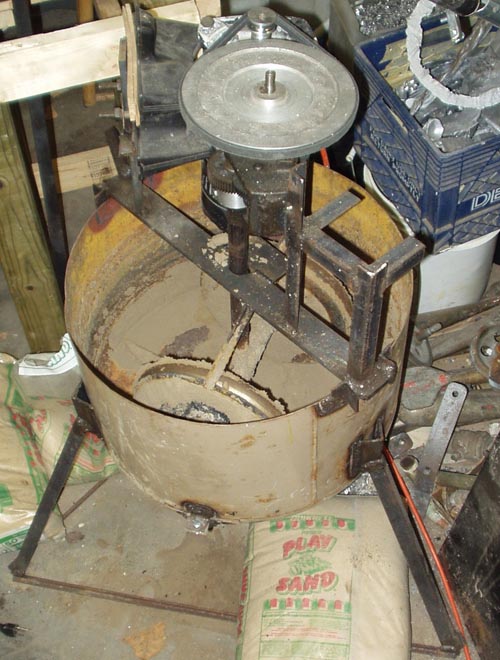Muller

This is my muller, powered by a 3/4 HP pump motor driving a pulley reduction, and from there to the gearbox from a washing machine. Final speed is around 75 RPM, which is faster than normal but still does a good job. There are two disadvantages to the design as pictured: one, that the plows don't extend up the sides of the drum, so a ring of sand builds up and has to be knocked back down manually; and two, that it's underpowered. Large lumps of sand will stall it out, and it can't start with more than about 20 pounds of sand in the drum, though it can mull up to twice that once it gets going.
In the summer of 2008, the gearbox seized up due to sand getting in the bearings of one of the gears. This gave me an excuse to add a new, more powerful 3 HP motor and an improved two-stage belt drive to handle the increased power, and a plow to keep sand off the sides of the drum. Unfortunately, the gearbox mount (steel welded to cast iron, which isn't exactly recommended procedure) failed under the increased torque, and it's still down pending fabrication of a more durable mounting system, probably some tapped holes for bolts.
Update 05/09: I ordered a brand-new gearbox that's actually rated for the torque load the muller needs to apply, and I'm in the process of installing it. Here's a picture of the gearbox:

Update 06/09: The muller is finished, and it works perfectly:

And a close-up from a different angle:

And finally, a short video (no sound, unfortunately) of the muller in action.
Molding and Casting
Pulleys
This is a pulley blank for my wood chipper project. It's posted here because that's exactly what a gate is supposed to look like: my freehanded gates are normally much messier. The riser looks funny because it had an insulating sleeve on it.
The pattern for the pulley above, along with a smaller split pattern. They were cut on the lathe, defects were filled and fillets made with water-based wood filler, and they were sprayed with clear lacquer. Note that I marked their approximate weight in aluminum: that's a handy thing to know without doing the calculations again if you want to use the pattern later.
Thin Castings

This is a mold of a saucer. Note the vent riser in the center of the cope, and the multiple ingates with circular runner. This is a very thin pattern, and I didn't want it to end up not filling completely. Also visible is my sandbox, which is on wheels and contains maybe 500 to 600 pounds of greensand. I've used most of it at once, too, when pouring castings from my big furnace. Making that many molds is literally an all-day procedure, sometimes more.

As you can see, it came out nearly perfect. This was poured with 6061, which is not a particularly fluid alloy, so I was happy when I saw that it worked.

0.084" thick over a 6" diameter? I can live with that.
